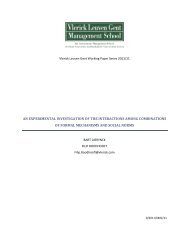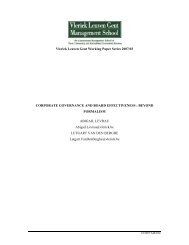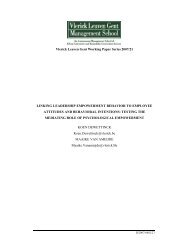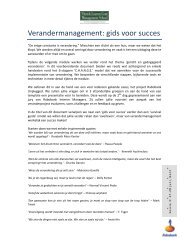innovation and internationalization by indian firms - Vlerick Public
innovation and internationalization by indian firms - Vlerick Public
innovation and internationalization by indian firms - Vlerick Public
Create successful ePaper yourself
Turn your PDF publications into a flip-book with our unique Google optimized e-Paper software.
of <strong>firms</strong> from emerging markets such as China <strong>and</strong> based on low cost arbitrage. In contrast, service<br />
based <strong>internationalization</strong> was based on <strong>innovation</strong>, <strong>and</strong> particularly <strong>innovation</strong> in business models.<br />
Take again the case of Bharti Airtel. In the second half of the 2000s, the company started<br />
internationalizing into neighbouring markets like Bangladesh where it invested US$ 500 million.<br />
Bharti later bought the African assets of Zain Communications, a Kuwait based telecom firm in 2010.<br />
In effect, what Bharti was trying to do was to apply its business model (i.e., its price focused,<br />
outsourcing of capital-intensive parts of the activity chain <strong>and</strong> system) to markets that it believed it<br />
could compete in – where there were some industry <strong>and</strong> institutional conditions that were still<br />
evolving. Similarly, after having gained a reputation for quality at low cost in medical services, Indian<br />
healthcare providers started exp<strong>and</strong>ing their scale-driven business model into some South-East<br />
Asian countries, such as Thail<strong>and</strong>, Vietnam <strong>and</strong> even Singapore. For example, Fortis Healthcare, a<br />
major Indian healthcare provider, exp<strong>and</strong>ed its footprint <strong>by</strong> buying into the assets of a cancer<br />
hospital in Singapore, with the objective of implementing the scale-sensitive business model that it<br />
had developed in Indian conditions, as well as gaining new capabilities from the advanced medical<br />
infrastructure in Singapore. 3<br />
In other industries, such as diamonds, the Indian entrepreneurs who had increasingly<br />
dominated cutting <strong>and</strong> trading, moved up the value chain <strong>and</strong> started offering a wider range of<br />
services such as financing <strong>and</strong> end-to-end logistics, thus adopting a one-stop business model for<br />
their buyers. In the highly visible IT industry, the model moved towards what was called a ‘global<br />
delivery model’ where clients’ needs were served with a combination of assets on site at the client’s<br />
location, in addition to the Indian company’s assets <strong>and</strong> capabilities in India, <strong>and</strong> sometimes in other<br />
parts of the world (such as China). In other words, in a number of industries, what was increasingly<br />
becoming innovative was not the product or the process, but the business model itself that was<br />
often rolled out in India, scaled, <strong>and</strong> then applied to particular overseas markets that had the right<br />
industry <strong>and</strong> institutional conditions needed.<br />
BOUNDARY CONDITIONS, LIMITS AND CHALLENGES<br />
We see that Indian <strong>firms</strong>’ use of <strong>innovation</strong> capabilities to successfully internationalize<br />
rested on two main choices. First, the choice of location (Emerging Market or Developed Market,<br />
<strong>and</strong> then which country in particular) <strong>and</strong> second the adaptation or adoption of existing or new<br />
business models. Successful Indian MNEs were able to find a fit between the home country (India)<br />
<strong>and</strong> host country institutional <strong>and</strong> industry conditions. They were able to leverage their internally<br />
3 See http://www.business-st<strong>and</strong>ard.com/india/news/qa-malvinder-mohan-singh-fortis-healthcare/426504/<br />
12










